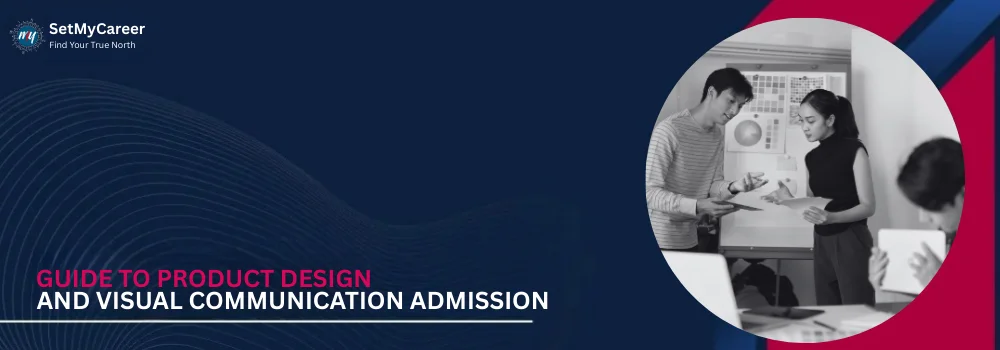
Published by SMC Team on 18 September 2025
SetMyCareer Editorial Team
SetMyCareer Editorial Team brings together expertise in career strategy, industry insights, and content excellence. The team is committed to delivering powerful, research-driven guidance that empowers professionals and students alike. With every blog, they aim to inspire bold career choices and lasting success.
Your design career starts with the right college choice. Learn how to assess programs, mentors, and industry exposure for success.

Evaluating a college for a Product Design or Visual Communication degree involves carefully considering both online and offline factors to ensure quality education and career readiness. Offline, key aspects include accreditation, faculty expertise, and infrastructure such as well-equipped design studios, labs with advanced prototyping tools, and access to industry-standard software. The curriculum should be comprehensive, covering essential skills like design thinking, 3D modeling, visual storytelling, and user-centered design, along with opportunities for hands-on learning through projects and internships. Strong industry collaborations and placement records also indicate good professional exposure.
Online Course Factors
Online factors focus on learning flexibility, quality of virtual content, and availability of interactive sessions and mentor support. Online courses may offer flexibility and accessibility but less hands-on experience with physical materials and real-world spaces, which is crucial for design disciplines. Evaluate the balance between theory and practical exposure, networking opportunities, and the robustness of career support services offered online.
Additional considerations include the college's reputation, alumni success, the presence of workshops or live projects, and global exposure opportunities such as international internships or study-abroad options. Comparing these aspects helps prospective students choose a program that matches their career goals and learning preferences, ensuring they acquire the skills needed to thrive in creative design industries.
Academic Quality
Accreditation & Recognition: Check national and international accreditation status and university affiliations.
Curriculum Relevance: Look for updated course structure emphasizing design fundamentals, digital skills, user experience, and emerging technologies.
Faculty Expertise: Qualified professors with industry experience, research background, and design portfolios.
Specializations & Electives: Availability of niche areas like UI/UX, animation, sustainable design, branding, etc.
Infrastructure & Facilities
Offline Labs & Studios: Well-equipped workshops, prototyping labs, art studios, computer labs with latest design software.
Online Learning Platform: Robust LMS with interactive tools, video libraries, live sessions, and technical support.
Library & Resources: Access to design books, journals, software subscriptions, and multimedia materials.
Practical Exposure & Industry Connection
Internships & Live Projects: Partnerships with companies for real-world practice.
Industry Mentorship: Access to practicing designers and guest lectures.
Placement Records: Track record of successful student placements or freelance opportunities.
Competitions & Exhibitions: Opportunities for portfolio-building through contests and showcases.

Get expert tips to evaluate product design and visual communication colleges for your future.
Start My EvaluationLearning Experience & Support
Teaching Methodologies: Blend of lectures, workshops, studio work, critiques, and collaborative projects.
Student Support Services: Career counseling, academic advising, mental health resources.
Peer Collaboration & Alumni Network: Active forums, clubs, and mentor networks promoting peer learning and professional connections.
Flexibility & Accessibility
Mode of Study: Availability of full-time, part-time, hybrid, and fully online options.
Geographical & Financial Accessibility: Scholarships, flexible payment plans, and campus location consideration.
Technology Infrastructure: Reliable internet, access to design tools remotely, and learner-friendly online interface.
Global Exposure & Growth Opportunities
International Collaborations: Joint programs, exchange programs, workshops with global institutes.
Innovation & Research Culture: Support for research, innovation labs, and student-led startups or design initiatives.
Outcomes & Career Pathways
Graduate Success: Alumni achievements in design industries, entrepreneurship, or higher education.
Career Services: Job placement assistance, portfolio review sessions, networking with design firms.
Entrepreneurial Support: Incubators, funding support, and guidance for starting design careers.
Placement Data
Companies: The types of companies (FMCG, Auto, IT, App Development, Ad and Design Agencies etc.), their reputation and consistency of campus recruitment.
Packages: The average salary package offered for 2-3 years, the highest package and the lowest package.
Type of Work: Look at the job role, project or division of a company for which the students were hired.
% of Placement: What % of students are getting placements and any downward trend is observed (in case the college shares the data honestly and openly).
This framework enables thorough evaluation, ensuring educational quality, practical skill development, and long-term career benefits for students pursuing Product Design or Visual Communication degrees.
When Dr Rathi, founder SetMyCareer, was working at IIT Bombay (1995-2005) as the Training & Placement Officer, he has coordinated the training & placement of M Des (Master of Design) students for 9 years. IIT Bombay’s IDC (Industrial Design Centre) is one of the premier design centres in the country. During his tenure at IIT Bombay there was no B Des course at IIT Bombay. The design student placement was just a one week activity at the end of 2 years of the course, as the number of students were hardly 30. There was another activity that was highlight of the IDC, the Design Degree Show. This use to happen at a prominent place such a Nehru Centre, Worli (Mumbai). Industry leaders were invited for the show, where the students use to exhibit their practical work to industry veterans. Many students use to get job offers also during the show. Companies such as Tata Motors, Maruti Automobiles, Godrej, Videocon, Mahindra & Mahindra etc were some of them.
No. 14/595, 1st Floor, Nanjappa Reddy Layout, Koramangala 8th Block, Bangalore 560095